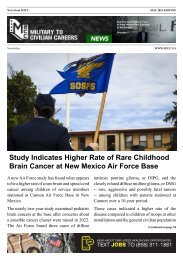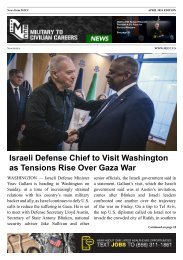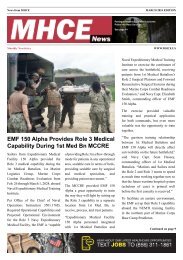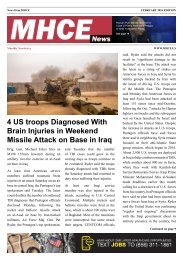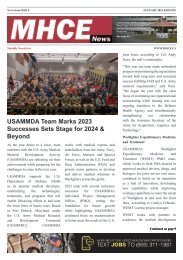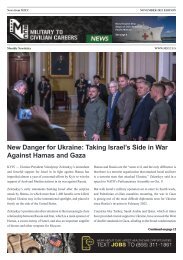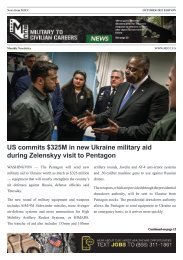May Edition
Create successful ePaper yourself
Turn your PDF publications into a flip-book with our unique Google optimized e-Paper software.
MAY 2020 EDITION
NEWS FROM MHCE I WWW.MHCE.US
MHCE News
More Than 180 Military Medical Students
Graduate Early to Help with COVID-19 Crisis
By Jared Serbu | @jserbuWFED
The normal graduation date for the
military’s latest class of uniformed health
care providers is still about six weeks
away. But on Wednesday, the Defense
Department’s premiere medical school
conferred degrees to nearly 200 new
doctors and nurses so that they can
begin to help combat the coronavirus
pandemic sooner rather than later.
The Uniformed Services University of
the Health Sciences granted degrees to
150 M.D. students and 33 advance practice
nurses, including clinical nurse specialists,
family health, women’s health
and mental health nurse practitioners,
officials said. Another 26 nurse anesthesia
students will graduate on May 1,
once they’ve met all of their educational
requirements.
For the most part, the new graduates will
stay in the national capital region to help
with the military’s immediate coronavirus
needs there before moving on to
residency programs this summer.
Dr. Art Kellerman, the dean of USU’s
F. Edward Hébert School of Medicine,
said the school’s first-ever “virtual
commencement” was possible mainly
because of a coincidence of timing.
“At this point in the academic year for
most medical schools, including ours,
students are finishing up final electives
that are nice to have — but not essential
to have — to fully complete a medical
degree,” Kellerman said in an interview
for Federal News Network’s On DoD.
“And so as we saw the coming storm of
COVID, we thought it was important to
lean forward with this class and have
them ready in the event that they need
to engage to support the mission.”
in early July. In the meantime, Defense
medical officials think there are numerous
crisis-related tasks they’re already
well qualified to perform, should they
be needed during DoD’s coronavirus
response.
He said that’s largely because USU’s
curriculum and internship programs
make its graduates, all of whom are
commissioned military officers, uniquely-prepared
to deal with a situation like
a viral pandemic.
“They take the same courses and they
have to pass the same tests that every
civilian medical school gives. But they
also get about 700 hours of additional
instruction in tropical medicine, operational
medicine, tactical combat casualty
care, portable ultrasound, telehealth,
and other skills that are vital on the
battlefield or when you’re practicing in
remote or austere settings, or when you
are put in a situation where you don’t
have all the facts or all the information,”
Kellerman said.
“When you have people with that
psychological makeup, who have gone
through field exercises for multiple days
in a row, or have done prolonged field
care with some of the top Special Operations
docs in the world, and tell them,
‘We’re going to need you to get ready in
the next four more days to potentially
start assessing COVID patients coming in
to Walter Reed,’ they’ll do it. They’ll rise
to the occasion. They’ve done it before.”
Now that most of this year’s graduating
class is finished with their USU schooling,
the university is focused on ways
to adapt its curriculum to incorporate
more distance learning, in case COV-
ID-19 and social distancing are still
factors in the fall semester.
ured out ways to move many of its classes
online. But there are parts of medical education
that are much more challenging to
adapt to a virtual environment.
“How do you do a clinical clerkship in
medicine or pediatrics or surgery, when
the entire hospital is focused for the moment
on COVID? The answer is you really
can’t,” he said. “So at the moment, virtually
every medical student in America is not
in a teaching hospital, doing what they
would normally do in surgery or medicine.
We hope to be one of the first schools
back with the ability to do that as we work
through this pandemic, but that hasn’t
happened yet.
How do you train students in procedural
skills that would typically require
students working together in very close
proximity to each other? That can’t be
done either under the current guidance,
so we have to find other ways to educate
them in those skills.
To some degree, we’re inventing this as it
goes along, and we’re freely sharing our
knowledge and skills with other medical
schools. We’ll get through this together.”
Kellerman said most of the students will
most likely start their formal residencies
Like many other colleges and universities,
Kellerman said USU had already fig-
2
MHCE News
MAY 2020 EDITION
EOTech’s Holographic Weapons
Sights Are Simply Amazing
The Buzz
While good eyesight and a steady
hand have always been crucial in
marksmanship, there have been
plenty of tools that have given the
shooter an edge.
One of the most important could be
the “Holographic Weapons Sights”
(HWS) developed by Michigan-based
EOTech.
Back in 1996, the company – which
evolved from a non-profit research
institute – first developed a prototype
holographic-based weapon sight for
use in U.S. Army helicopter gunships
and anti-aircraft artillery systems.
Then in 1993 ERIM formed the Michigan
Development Corporation (MDC)
to commercialize technology that
could be spun off as for-profit subsidiaries
and in 1995 this lead to the
creation of EOTech.
This led to the first-generation HWS,
which was marked under the trade
name Bushnell HoloSight – a product
that won the Optic of the Year Award
from the Shooting Industry Academy
of Excellence.
In 2001 the military and law enforcement
communities adopted the HWS
sights, and in 2005 Special Operations
(SOCOM) and the United States
Marine Corps chose HWS as their
standard close combat optic.
Advantages of HWS
The primary advantage of HWS is
that it provides an extremely fast and
easy target acquisition for operators
in the field, and this includes both
eyes open for engagement, which
allows for full peripheral vision and
situational awareness – something
that is crucial for those in combat situations.
The sight’s anti-reflective coatings
and flat front window further minimize
image distortion and muzzle
side reflection, while the sights also
offer optimal off-axis usage when
proper cheek weld or sight alignment
isn’t possible.
HWS technology has an advantage
over standard “Red Dot” sights – the
latter utilizing an LED light source
and reflex sight. The HWS system
instead is built around a laser diode,
folding mirror, collimating reflector
and holographic grating. The holographic
reticle can even continue to
function when the window is broken
or obscured, something no other sight
can do.
The HWS also utilizes a “Speed Ring”
reticle, so that the outside to outside of
the circle equals a 5-foot 9-inch man
at 100 yards.
The all-weather sights are water-resistant
to thee to 10 meters depending
on model, and will perform in temperatures
ranging from -4ºF to 1224ºF.
Unlike most Red Dot sights, HWS is
also night vision-compatible, offers a
wide field-of-view, even when used
with a helmet or weapon-mounted
night-vision devices.
An NV toggle button also allows operators
to instantly switch from NV to
daylight to the last setting used. The
sights offer adjustable reticle brightness
with 30 settings for NV models
and 20 for all non-NV models.
Commitment to Quality
The Southeast Michigan company
was acquired in 2005 by L3 Technologies,
one the world’s largest defense
contractors with more than $9.6 billion
in sales in 2017.
EOTech is also the only consumer facing
division and it currently operates
out of a 30,000 square foot facility that
is truly a mix of traditional assembly
line production utilizing skills workers
with high-tech quality control to produce
truly cutting edge products.
Part of the Michigan-based company’s
commitment to quality was to repair
its reputation and trust with customers
following the civil fraud lawsuit
that involved defective rifle sights.
That included parent company L3
Technologies paying $25.6 million to
settle a lawsuit that accused the defense
firm of reportedly knowingly
selling optics that failed in extreme
temperatures and humid weather
conditions.
In 2017 the company even held a voluntary
buyback of sights, and the defective
products were then sent to be
crushed and destroyed.
EOTech was awarded a $26.3 million
five-year contract from the U.S. Special Operations
Command (USSOCOM) to provide
close-quarters sights and clip-on magnifiers
for the Miniature Aiming System–Day Optics
suite.
Peter Suciu is a Michigan-based writer who
has contributed to more than four dozen
magazines, newspapers and websites.
He is the author of several books on military
headgear including A Gallery of Military
Headdress, which is available on Amazon.
com.
WWW.MHCE.US MHCE News 3
TRANSCOM Awards $7B to Revamp
Military Moving Process
addresses long-standing pain points DoD
families have highlighted for years.”
The Global Household Goods contract puts
one company in charge of overseeing hundreds
of contractors helping with the more
than 400,000 military moves conducted
each year.
The contract is supposed to cut back on accountability
problems within the moving process.
Some of those were illuminated in a DoD
Inspector General report from earlier this
year, which found 41% of shipments made
by moving contractors and reviewed by the
DoD IG were not delivered on time.
By Scott Maucione
U.S. Transportation Command
awarded a more than $7.2 billion
contract that will completely
change the way the Defense Department
manages military moves.
TRANSCOM awarded the contract
on Thursday to American Roll On
Roll Off Carrier Group (ARC), located
in Parsippany, New Jersey.
“DoD families are our north star
and the reason we are making this
change to the Defense Personal
Property Program,” said Army Gen.
Stephen Lyons, USTRANSCOM
commander in a Thursday statement.
“The contract was written by
and for the military services, and
Right now, those duties fall to 42 separate
government-managed shipping offices,
each of which hires moving companies on
a one-off basis each time a service member
receives permanent change of station (PCS)
orders. TRANSCOM said that decentralized
system is “fundamentally flawed,” mainly because
it doesn’t allow for long-term contracting
relationships with movers, and gives the
government few ways to hold them accountable
for poor performance.
“We need to gain accountability of industry
and we need to improve responsibility in
the department, because it’s bifurcated today,”
Lyons said in January. “At the end of
the day, we want to create the right incentive
structures so that during peak season, when
most of the moves take place and capacity
is depleted, we can increase the capacity to
support peak-season moves. That’s our objective.”
TRANSCOM and ARC will spend the next
nine months integrating IT systems and processes.
The first move under the new system
will be conducted next February and
ARC will be in charge of all of the domestic
moves during the peak summer season of
2021. It will handle all domestic and international
moves by the summer of 2022. ARC
partnered with a group of subcontractors to
carry out the moves and will ensure at least
40% of domestic work flows down to small
businesses.
“Small businesses are—and will remain—the
backbone of this program,” said Rick Marsh,
director of the defense personal property
program at USTRANSCOM. “If a company delivers
a quality product in today’s program,
there is room for them in tomorrow’s. Their
capacity will remain critical as long as DoD
moves personnel and their families around
the globe.”
4
MHCE News
MAY 2020 EDITION
WWW.MHCE.US MHCE News 5
Why Top Business Schools Want Veteran
MBA Students in Their Classrooms
By Kelly Vo
Veterans make excellent MBA candidates.
From well-developed leadership skills
to creativity, resiliency, adaptability, and
perseverance, they have many of the attributes
required to be successful both in the
military and in business. They make versatile
candidates and employers with a high
record of success.
In honor of Veteran’s Day, we thought we’d
interview four veterans who are attending
some of the top MBA programs in the country:
NYU Stern School of Business, MIT Sloan
School of Management, and the University of
Pennsylvania’s Wharton School. Our goal is
to share their stories and provide reflections
from their time in the military.
Going Back to School to Explore OpportunitiesEarning
an MBA is a great way to open
up new employment opportunities, particularly
when leaving the military for life as a
civilian.
An MBA can help you develop a better idea
of what you want to accomplish in the future
while also helping you develop the knowledge
and insight necessary to succeed in
the business world.
That was the case for Lorelei Gaus, a second-year
MBA student at the Wharton
School. “I decided to earn an MBA because
it was so far outside my previous education
and background.
I had never taken an accounting or finance
course before Wharton, and I knew that I
really lacked in this department,” she told us.
After just a year at Wharton, Gaus feels like
she already has so many more tools in her
arsenal to not only understand but rigorously
analyze complex business problems.
As for Chris Costello, a second-year MBA
student at NYU Stern, earning an MBA was
a way to take his military experience and
leverage it in business. “I gained a lot from
my military experience and am thankful
for having worked with very high-caliber
people on impactful missions,” he explained.
“Coming to NYU Stern has been a tremendous
way to transition. The administration
does an incredible job of supporting student
veterans.”
Military Preparation for the MBA
No veteran comes into the MBA world without
a wide variety of valuable experiences
already. The truth of the matter is that many
skills that are vital to a successful military
career are immediately transferable toward
an MBA.
For Sam Daly, a veteran in NYU Stern’s
Class of 2020, that was definitely the case.
“Time management, leadership, backward
planning, working with people from diverse
backgrounds, and staying organized are all
things that most successful service members
should have in their skill set, and they are
crucial to succeeding in an MBA program,”
he explained. “Another thing that a military
background provides MBA candidates is
perspective and resiliency. Our real-life
experiences serve as a ballast against the
stressors and anxieties of entering a new
chapter of our lives.”
It was the same for Ashley Pelzek, a second-year
MBA student at MIT Sloan. After
being in the military for 11 years, she had a
lot to bring to her MBA experience. “Business
schools look for candidates who are
innovative, creative, and demonstrate leadership
qualities,” Pelzek said.
“You would think that creativity and innovation
would be difficult for veterans used to
following orders, but we’re actually really
good at taking assignments and figuring out
creative solutions in impossible situations.
That’s what we’re faced with all the time in
the military.”
The difficulty is knowing how to demonstrate
those qualities in a resume and on an application.
But a quality MBA program will help
you figure out how to convey all your military
experiences in a way that makes sense
for business.
6
MHCE News
MAY 2020 EDITION
DOD NEEDS TO USE A SCALPEL
IF IT CUTS MEDICAL FORCE,
MEDICAL CORPS EDUCATOR SAYS
By Scott Maucione
As the military changes
its needs to focus on
near-peer competition,
the Pentagon needs to
be careful about how it
readjusts the size of its
medical corps.
Richard Thomas, president
of the Uniformed
Services University — a
federally-funded school
that trains medical and
nursing students for
military service — says
the Defense Department
can’t readjust its
medical personnel with
a “sledgehammer or a
meat cleaver,” but rather
must take a scalpel to the
corps.
Thomas’ comments
come as multiple outlets
reported that DoD is considering
cutting its medical
corps by as much as
17,000 people. The plan
is to convert those billets
into combat-ready service
members to make
the force more lethal.
Thomas told Federal
News Network that DoD
sent the services targets
for how much they
should cut their medical
staff and the services
are now calculating if
those cuts are possible.
The current active duty,
reserve and guard medical
corps has about
186,000 staff.
“This is really not unusual,”
Thomas said. “At
the end of every cycle of
heightened operations
or combat operations
we tend to have a right sizing
of the force and that’s
what’s going on here.
The military is saying
‘OK, let’s look at what you
have grown in the medical
community. What do you
need, what’s your requirement
and then we will adjust
accordingly.’”
Thomas said one thing is
different about the way
the military reassesses its
medical corps as it distances
itself from the Middle
East and focuses more
toward Russia and China.
That difference is the Defense
Health Agency — the
umbrella medical organization
formed in 2013 that
will take many medical
responsibilities from the
services.
“It’s not just the services
on their own doing the assessment,”
Thomas said.
“One of the main functions
of DHA is to help to coalesce,
so you are looking at
things from an enterprise
perspective and not from
as separate service perspective.”
Still, DoD relies on the
services’ ability to tell
the Pentagon what they
need.“What is the medical
capability we want to
be able to project around
the globe to support our
forces in austere environments?”
Thomas said. “The services
have the responsibility
of defining that requirement
to meet that capability
requirement.”Assessing
the size of the medical
force may be more contentious
than it seems,
however.
A Feb. 21 Government
Accountability Office report
found DoD does not
have a uniform way of deciding
how much medical
staff it needs, and therefore
cannot properly determine
the right size of
the medical force.
“Until DOD establishes
joint planning assumptions
for developing
medical and dental personnel
requirements, including
a definition, and
a method to assess options
for achieving joint
efficiencies, DoD will not
know whether it has the
optimal requirements to
achieve its missions,” the
report said.
The military departments
have applied separate
and different processes
and assumptions
to decide how many
medical staff are needed.
The report goes on to
state that DoD plans to
develop a uniform metric
for 72 medical specialties
to deal with the
issue, but those metrics
are not in place and
could be expensive to
implement.
DoD has yet to fully
budget for the implementation
of the metrics,
but GAO says they are
essential.
“Until DoD determines
the critical wartime
medical specialties to
apply its clinical readiness
metric and estimates
the costs and
benefits of applying the
metric to each, it will not
know if its implementation
is being targeted to
the areas of greatest return
on investment,” the
report said.
DoD agreed with six
recommendations set
out by GAO it rectify the
issue. The recommendations
include applying
joint planning assumptions
and methods when
determining the size of
the medical force and
estimating the cost and
benefits of using the DoD
metrics to decide if the
approach should be revised.
WWW.MHCE.US MHCE News 7
CORONAVIRUS ROBBING GRANDPARENTS
OF PRECIOUS TIME WITH FAMILIES
By Ethan Sacks
Instead of being able to throw a
party worthy of matriarch Barbara
Burr’s milestone birthday, the coronavirus
pandemic forced her family
to improvise.
The mother of nine, grandmother
of 22 and great-grandmother of 37
was instead whisked outside of her
home in Eau Claire, Wisconsin, on
April 18 — her 90th birthday — for a
surprise car parade in her honor.
“It is was extra special, out of this
world,” Burr said. “Only I felt so bad
when they all left and I couldn’t give
them all a hug.”Burr, who lives with
her 95-year-old husband, Gerald,
is hoping she will get a chance to
hold them all again in her arms. “It
could take years,” she said of what
she calls “this germ that’s floating
around,” adding that by then, “I’ll be
long gone.”
Even as stay-at-home protocols are
lifted across the country, health experts
are recommending that older
Americans stay indoors and avoid
contact with potential virus carriers
— including family members who
aren’t sheltering in place with them.
That means that until a vaccine is
readily available, grandparents will
lose precious time with their children
and grandchildren.
There is, of course, good reason for
all that social distancing: COVID-19
poses a disproportionate danger to
seniors. In New York, the hardest-hit
region in the country, 84.5 percent
of deaths attributed to the virus
were of people aged 60 or older,
according to the state’s health department.
“The relationship between grandparents
and grandkids are important
for mental health and emotional
health, as well physical health,” said
Alison Bryant, senior vice president
of research for AARP.
“You know grandparents just enjoy
it, but there are real health implications
of not being able to spend time
with grandkids.” In the absence
of regular physical contact, other
types of contact are key.
Bryant said family members can
make a big difference by using
phone calls and video chats to
maintain contact. Seeing the faces of
loved ones is important, preferably
with some kind of regular routine.
Amy Fuchs, owner of the Elder Expert
consulting service, has said
there is a marked difference in the
way seniors are handling the dislocation
caused by COVID-19 that
overlaps with their ages.
“What I find is that the younger cohort
(aged 60-75) is more adept at
social media and technology and
smartphones,” said Fuchs, a clinical
social worker. “So I’m a little less
worried about them, because they
have the ability to access Zoom or
other platforms to be in touch with
their families.”
For her clients over 80, particularly
those who live alone, however,
Fuchs is already seeing an increase
in memory issues weeks into the
forced isolation.
“They’ve lost the social interaction,
and you don’t realize how much
they gain from that,” said Fuchs.
“They live for the trips to the grocery
store. They live for the trips
to the pharmacy. They live for the
trips to the physical therapist.”
That isolation has been particularly
stark for seniors who have come
down with the coronavirus and
forced to battle for their lives in hospitals
or nursing homes, where family
members are barred from being
at their sides.
The last time Kristen Lathrop saw
her grandmother, Goldie Mae
Moran, was as Moran was being
whisked from an ambulance into
the emergency room of Hartford
Hospital in Connecticut. Because of
the highly contagious nature of the
disease, the staff did not allow Lathrop
to get too close.
“I kind of shouted across the room
to let her know that I was there,
because I didn’t know if she didn’t
have a phone,” recalled Lathrop, a
psychiatrist. “She was like, ‘Where
are you?’ And I just wanted her to
know I was there. I said, ‘I love you,’
and I just kind of knew that those
would be my last words to her.”
Her grandmother died days later, at
5:28 a.m. on her 88th birthday, with
a hospital staffer at her bedside to
hold up a phone for family members
to say goodbye.
“These are moments when you
want to hold someone’s hand and
look them in the eyes so they can
see your face to give them some closure,”
Lathrop said.
Seniors, however, do have one advantage
over their younger coun-
terparts in adjusting to this radical
new societal landscape — life experience.
“For a lot of older folks who havegone
through challenging situations
through their lives, they can
rely on skills they developed over
those previous experiences,” said
Dr. Ellen Whyte, director of geriatric
psychiatry outpatient services
at the University of Pittsburgh’s
Western Psychiatric Hospital.
And if there is another silver lining,
it’s that the proliferation of the
coronavirus has brought with it
a simultaneous spread in empathy.
The whole idea of “flattening
the curve” is based on the idea of
not getting someone else sick, especially
when the risks increase
with age.
Grocery stores across the country
are restricting access at specific
times, often early in the morning,
to allow seniors a chance to shop,
while social media is full of stories
of good Samaritans buying food
for their elderly neighbors.
“Now, people who are not senior
citizens are sort of experiencing
some of the isolation that many
senior citizens face day in and
day out,” Whyte said. “So hopefully
they’ll be more sensitive to that
isolation that can occur as people
get older and reach out more to
our older relatives, friends and
neighbors on a regular basis — not
just through this crisis, but going
forward.”
In Wisconsin, Burr’s family celebrated
the birth of her first greatgreat-grandson,
Royale, in March.
But while the nonagenarian has
already crocheted a blanket for
the newest addition to the Burr
clan, she can’t meet him in person
because of the lockdown.And
Crystal Burr, one of her 22 grandchildren,
worries that the family is
on a ticking clock.
“We all worry about the health of
my grandmother and grandfather,
and we worry if we’re going to
get the chance to hug them ever
again,” the younger Burr said.
“Their health is declining and it’s
heart-wrenching to think about.”
“Every day is a gift,” she added,
“but tomorrow is never a
promise.”
8
MHCE News
MAY 2020 EDITION
Don’t let Nurses Month Pass You By.
Here’s How to Celebrate Virtually.
HELP SLOW
THE SPREAD!
By Katherine Virkstis, ND, Managing
Director
It’s bittersweet to think about 2020
as the “Year of the Nurse.” The Covid-19
epidemic has forced nurses to
risk their personal safety to deliver
care—many in some of the most difficult
practice environments in living
memory. Yet there has been no finer
showcase of nursing excellence, fortitude,
compassion, and ingenuity than
the past four months.
Nurses Month celebrations to commemorate
the “Year of the Nurse” are
slated to begin May 6 and run through
the entire month of May.
While some organizations have postponed
their celebrations to protect
nurse and patient safety, I recommend
that all leaders use this month as an
opportunity to recognize and thank
nursing staff for their heroism.Below
are a few ideas I’ve collected for how
to celebrate your nursing workforce
safely:
Host a virtual awards ceremony.
Granting DAISY Awards or other recognition
of achievement is usually the
cornerstone of nursing celebrations.
Even if you decide to postpone an
in-person celebration, try to still host
a live (albeit virtual) event for your
honorees.
For example, some organizations are
hosting a virtual recognition dinner
with the full leadership team, with
dinner for two delivered to each of the
honorees’ homes.
Thank their families. Nurses’ families
have been making sacrifices throughout
the epidemic so their loved ones
can deliver care.
Show your appreciation by mailing a
thank-you note and a token of gratitude—for
example, a pizza-making kit.
Create spaces for nurses to share their
stories. Give nurses an opportunity to
recognize their peers by creating a
live forum to share their stories on the
front line.
If asking staff to join a meeting is too
time intensive, you can collect video
clips or photos in advance and compile
them in a video to be shared on
your organization’s website and
intranet.Ask the community to share
their thanks.
Nursing has rarely been as publicly recognized
as it is today. Give the community
the opportunity to share their thanks
with your staff.
You can ask your marketing department
to create a forum where the public can
share videos of themselves thanking
your organization’s nurses—which can
be compiled and shared throughout the
month. Another option is to encourage
community leaders to start a cloth face
mask drive for hospital staff.
Have executive leaders publicly express
their gratitude. Many organizations are
creating videos of the executive team
thanking nurses for their service. Other
options are to do a live panel session of
nurse leaders to share their stories, or
send a thank you note on behalf of nursing
leadership to each nurse’s home.
Offer a chance to connect with nursing
leadership. Nursing leaders can make
themselves personally available to staff,
as long as it meets hospital safety standards.
For example, one organization is
planning a “Latte with Leaders” event,
where staff can connect with nurse leaders
stationed by a free 24-hour coffee
cart.
Leverage community food donations.
Food, another staple of nursing celebrations,
has rarely been more plentiful as
local business across the country donate
meals to hospitals. Take advantage of this
generosity by doubling down on food-related
recognition.
Send meals to each unit, deliver dinner
to nurses at home, or designate each day
of the week to a different snack available
to nurses. Another option is to hire an ice
cream truck to visit different sites across
the system—managers can come pick up
treats for their team at staggered times to
avoid a crowd.
Keep the “blessing of the hands.” A “blessing
of a hands” ceremony can be a particularly
meaningful tradition for staff. It’s
also one of the most difficult to do virtually.
Even if your organization postpones
their in-person blessing, keep the spirit
of the ritual alive by having a chaplain
do a blessing virtually or via overhead
announcement. Another option is to give
staff bookmarks or other mementos with
the blessing inscribed.
WWW.MHCE.US MHCE News 9
Covid-19 Pandemic Likely to
Last Two Years, Report Says
By John Lauerman
The coronavirus pandemic is likely to last as long as two years
and won’t be controlled until about two-thirds of the world’s population
is immune, a group of experts said in a report.
Because of its ability to spread from people who don’t appear to
be ill, the virus may be harder to control than influenza, the cause
of most pandemics in recent history, according to the report
from the Center for Infectious Disease Research and Policy at the
University of Minnesota. People may actually be at their most
infectious before symptoms appear, according to the report.
After locking down billions of people around the world to minimize
its spread through countries, governments are now cautiously
allowing businesses and public places to reopen. Yet the
coronavirus pandemic is likely to continue in waves that could
last beyond 2022, the authors said.
“Risk communication messaging from government officials
should incorporate the concept that this pandemic will not be
over soon,” they said, “and that people need to be prepared for
possible periodic resurgences of disease over the next two years.”
Developers are rushing to make vaccines that may be available in
small quantities as early as this year. While large amounts of vaccine
against the 2009-2010 flu pandemic didn’t become available
until after the outbreak peaked in the U.S., one study has estimated
that the shots prevented as many as 1.5 million cases and 500
deaths in that country alone, the report said.
The report was written by CIDRAP director Michael Osterholm
and medical director Kristen Moore, Tulane University public
health historian John Barry, and Marc Lipsitch, an epidemiologist
at the Harvard School of Public Health.
10
MHCE News
MAY 2020 EDITION
AS UNEMPLOYMENT
SURGES, DEPARTMENT
OF VETERANS AFFAIRS
GOES ON HIRING SPREE
Veterans and service members speak with business representatives about job opportunities
at the Recruit Military Job Fair in San Diego on July 11, 2019. (Jake Mc-
Clung/U.S. Marine Corps)
Military.com | By Richard Sisk
Backed by a record $240 billion budget, the Department
of Veterans Affairs has gone on a hiring
spree to fill long-vacant spots as it battles coronavirus,
pulling from the ranks of the retired and
those furloughed or laid off by other health care
systems.
From March 29 to April 11, VA hired 3,183 new
staff, including 981 registered nurses, a 37.7% increase
from the prior two-week period, VA said
in an April 24 release.
In the next several weeks, the VA plans to add
4,500 more staff members, department secretary
Robert Wilkie said in a statement.
“Many of VA’s new hires come from health care
systems that have seen temporary layoffs due to
COVID-19,” VA officials said in the release.
As the number of coronavirus cases surged, the
VA began a national campaign to hire more registered
nurses, respiratory therapists, anesthesiologists,
housekeepers, supply technicians and other
medical personnel to work in its 170 hospitals
and more than 1,200 clinics nationwide.
The hires boosted the VA’s workforce to a record
390,000, or “nearly 55,000 more than we had five
years ago,” the VA spokeswoman said.
However, the 390,000 figure for the total VA workforce
was only 4,000 above the 386,000 number
reported at a hearing of the House Veterans Affairs
Committee in September 2019.
VA Inspector General Michael Missal testified at
the hearing that staffing shortages were “a root
cause for many of the problems in veterans care.”
In his statement to the committee last Sept. 18,
Missal said his office had reported on staffing
shortages at the VA for the previous four years.
He noted that the Veterans Health Administration
had made significant progress on hiring but said
it continues to face challenges, including the higher
pay offered by private health care systems.
As of Monday, the VA had reported a total of 434
coronavirus deaths of patients in the VA health
care system, and a total of 7,001 veterans in VA
medical care who had tested positive for the virus.
WWW.MHCE.US MHCE News 11
12
MHCE News
MAY 2020 EDITION
Our ‘Corona Project’
By VICTOR DAVIS HANSON
.Whatever we eventually call it, there is a
coronavirus “project.”
Chemotherapy
It’s a race to identify the origins, nature,
and danger of the SARS-CoV-2 virus and
the best way to treat, vaccinate against,
and mitigate the effects of the COVID-19
disease — all without destroying America
to save it.However the Corona Project
is defined, it remains different from all
previous existential American efforts.
We are not building any new weapon or
infrastructure or deliberately adopting a
radical new policy. Much less are
Americans fighting a visible enemy, poverty,
or just bad habits.
Instead, we are giving ourselves massive
social and economic chemotherapy
to weaken or retard the virus within us
before our massive therapeutic shutdown
kills the U.S. economy — a sort of neutron
bomb that destroys human interaction
without incinerating visible infrastructure.
In other words, we the patient apparently
must be sickened to the point of near death
in order to survive the disease.
It is certainly difficult to compare similar
American mass efforts in the past. Their
costs are murky — and not just because
of inadequate record keeping, the adjustment
of prior dollars to current time and
inflation, or the need to consider the relationship
between lives and money. In addition,
the tab for past “wars on” something
or other (e.g., alcohol, illiteracy, smoking,
poverty, drugs, etc.) usually rippled out for
years, both positively and negatively.
While there were efforts to mitigate the
1918 and 1957 flus and summer polio outbreaks,
along with smallpox, yellow fever,
typhoid, and cholera epidemics, we’ve
never seen anything comparable to the
reaction to the coronavirus. So it is hard
to calibrate the expense of the Corona
Project’s shuttering of the American
economy for what will probably turn
out to be a period of almost two months
and far longer in some places.
We are told that the Manhattan Project
cost in our present currency some $23
billion. Leave it to others whether that
“investment” saved or took more lives.
It certainly ended the war in the Pacific
without an invasion of Japan, spawned
peacetime nuclear energy, and created
deterrence in the Cold War that might
have prevented a Soviet invasion of
Western Europe.
The B-29 bomber program, which both
delivered the bomb and napalmed most
of the industrial output of Japan, cost almost
twice as much as the Manhattan
Project, at over $40 billion in today’s
dollars. The huge plane led to quantum
leaps in aircraft design. Without it,
the atomic bombs probably could not
have been dropped (The superb British
Avro Lancaster had the capacity to
carry such huge bombs but perhaps not
the speed or ceiling to ensure that the
bomber could be suitably distant after
dropping the weapon, or even had the
range to fly from and return to the Marianas).
NASA’s various space programs probably
have cost far more than the often
cited $1 trillion price. But going to the
moon likely more than paid for itself in
a variety of ways — in spin-off industries,
new technologies, invaluable scientific
data, and the emergence of a new sense
of increased national prestige.Critics of
the F-35 joint-strike fighter claim that it
will cost in toto over $1.5 trillion in all related
costs during its lifespan.
We have no idea how they can come up
with that number, only that the plane
is far more expensive than what was
initially promised. The interstate highway
system’s first phases probably cost
around $500 billion in today’s money
— and saved hundreds of thousands of
lives in its first few years.
World War II, aside from well over
400,00 American dead and the resulting
generations of disability and mental-health
issues, cost the U.S. in modern
currency over $4 trillion, despite turning
a lingering Depression-era economy
into a global juggernaut. No doubt the
actual related expense was trillions of
dollars higher.
Few have accurate figures on recent optional
wars. But general estimates put
the 19-year-long Afghanistan war at $2
trillion, and the 2003-08 active war in
Iraq at another $2 trillion — with more
than 7,000 American deaths in action
or related to both wars.No one has yet
calculated accurately the full cost of our
great gamble of shutting down most of a
$22 trillion economy.
To do so would spark heated controversy.
But we should at least agree that the
U.S. has never tried anything similar to
the present shutdown and that its costs
will exceed any project and likely any
war in our history. We are literally paying
an economic price comparable to
the costs of the Space Race, the Manhattan
Project, the interstate highway system,
and several wars several times over
all at once.
On the one side, supporters of the national
shelter-in-place policies would argue
that without these Draconian measures,
hundreds of thousands would have died
and that, even before government action,
many were already shutting down
the economy out of their natural fear and
precaution.
the other hand, critics suggest that
emerging herd immunity would eventually
have reduced that number of
deaths radically. In addition, as skeptics
such as scientists John Ioannidis and Jay
Bhattacharya of Stanford (among others)
have argued, we could see far more
people die from the neglect or delay of
treatments for critical diseases including
cardiovascular problems and cancer,
as well as from suicides, anxiety or
depression, increased substance abuse,
and spousal and familial violence. The
anthropogenic cost is about $3 trillion,
or $4 trillion, or $5 trillion — or is it now
$7 trillion? — in lost stock-market value,
federal borrowing, radical distortions in
consumer and government spending,
destroyed business infrastructure, and
lost GDP.
Whatever one’s views of the lockdown,
most will concede that shutting down
most of a postmodern-21st-century
economy incurs insidious costs not applicable
to previous quarantines or Manhattan-like
projects or large wars. The
decision to do so was, by needs, made
in haste to prevent what was forecast
as a true national pandemic that would
kill, we were initially told by some modelers,
up to 2.2 million Americans. That
horrific toll would have dwarfed even
the 500,000 to 800,000 who died in
the 1918–19 flu epidemic‚ and indeed far
more than all U.S. wars combined.
Other underappreciated factors explained
the panic surrounding the rapid
decision. The virus did not start in the
U.S. or “Spain” but in Communist China
— a totalitarian regime locked in an existential
trade war with the U.S. with a bad
record of spawning viruses. From the
very beginning, all news about the epidemic,
and indeed all policies directed
against it, were determined by the Communist
Party’s own self-interest — defined
as ensuring China’s unimpeded trajectory
to global hegemony.
Data were destroyed. Researchers were
silenced — or worse. News blackouts followed.
All information about the origins,
CONTINUE ON PAGE 13
WWW.MHCE.US MHCE News 13
CONTINUED
transmission rates, and scope of the pandemic
either was censored or massaged
to such a degree that the numbers and
dates changed weekly.
To this day, no one has any idea how
many Chinese citizens have died or
been infected from COVID-19. We will
never know. China’s Patient Zero supposedly
appeared in late January, or
was it mid-November? And who knows
when he will be reinvented next?
We still do not know the role of either the
Wuhan wet market or the level-4 viral
lab just a few miles from it. The Chinese
seem far more sensitive to charges that
lax safety standards in their sophisticated
postmodern laboratory sparked the
outbreak than to the writ that their premodern
butcher market was culpable.
In the end, it may prove that the latter
was a propagandized ruse for the real
culpability of the former.
That China locked down Wuhan and forbid
internal travel to and from Wuhan,
while allowing its quarantined residents
to fly directly into Europe and the U.S.
was the most telling of all Chinese outrages.
That fact alone should remind
those who cite xenophobia and racism
during this mess that they may be right
— but the perpetrators were always Chinese
racists, not American or European
ones.
The Causes of the Panic
We did not go through such hysteria in
2009 under the Obama administration
or in 2017 under Trump. Both were severe
flu years. The 2009 swine-flu outbreak
was scary in that it attacked all
ages and infected a supposed 60 million
Americans. The 2017 flu did too
but killed over three times as many, perhaps
more than 60,000. The flus of 1957
and 1968 respectively killed more than
100,000 Americans without national
lockdowns.
Why the difference in those responses
from today? 2020 is an election year.
Trump is hated, not just opposed, by the
media, Democrats, and the Never Trump
former Right. The longer the lockdown
and epidemic, the more his enemies
sense that the virus might do what neither
Mueller’s team nor impeachment
could.
The name “corona” is strange and not
familiar. Had the SARS-CoV-2 virus just
been wrongly labeled “Influenza C,” the
panic might have been less, regardless
of the actual costs in human lives or the
differences between an influenza and a
coronavirus. The virus itself seems especially
horrific in how it slowly strangles
and torments the elderly and the compromised.
So far, the coronavirus’s lethality rate
among those infected seems comparable
to the flu but it could also be more contagious.
So, in theory, we don’t yet know
whether its likely toll of 1 to 2 deaths per
1,000 infected will be rendered less relevant
— if 150 million Americans, not the
normal flu tally of 30–60 million cases,
become exposed and thus in theory
150,000 could still die. It seems unlikely
with the virus already peaking, but again
no one knows.
Corona is also fickle. It seems not to kill
99.9 percent of those infected who are
under 60 and in good health, but, very
rarely, it can kill someone hale and
young. And the virus does so in a cruel
fashion of mimicking a mild flu for days
only to trigger a hyper-immune response
that induces the body to kill itself.
Vigorous health-care workers on the
front lines are rewarded for their courage,
in Thucydidean fashion, with daily
blasts of heavy infectious loads that occasionally
can wear down the immunity of
even the youngest and healthiest.
Given the eternal nature of the news, we
are fed every gory detail about the 1 in
1,000 deaths, but we hear almost nothing
about the 999 healthy and under-60 corona
patients who suffer few or at least
tolerable symptoms. There is not yet anything
comparable to the hit-and-miss
influenza vaccination. Our media, to be
fair, is not just not fair and not sensationalized.
It’s politically weaponized, globalized,
and propagandized.
Partly media bias is due to the nature of
global bicoastal affluence and elitism (the
major media and their affiliated social
media and entertainment are centered in
the power foci of New York, Washington,
Los Angeles, and Silicon Valley). Partly,
the role of the influential and media-centric
New York corridor, where almost half
the country’s fatalities have occurred, explains
the asymmetrical coverage.
Partly, media incompetence, arrogance,
and partiality reflect the failure of journalism
programs and graduate schools
to teach writing skills, ethics, and professionalism.Partly,
the causes are the Internet,
emails, and social media that translate
unsourced hysterias into news to
win instant market share and clicks from
global thumbs-up/thumbs-down electronic
audiences.
Like it or not, unlike the Manhattan Project
or the B-29 program or the Space
Program or the War on Drugs or even the
earlier response to 1918–19, flu, the Corona
Project is seen as the determinant of
the next presidency as well as an adjudicator
of a growing factionalism last seen
in the pre–Civil War divide. In very general
terms, our polarization today pitts a
more globalized and affluent, progressive,
bicoastal nation against its more traditional,
populist, and nationalist interior
antithesis.
That is no exaggeration, given that almost
every decision of this crisis — keep or end
the lockdown, end shelter-in-place, borrow
and spend $3 trillion or $5 trillion,
use or don’t use hydroxychloroquine,
defund or increase funding for WHO — is
seen as either hurting or helping Donald
Trump or Joe Biden in November, and
by extension the sort of culture each has
come to represent. There is one difference,
however, from past experiences of
“the war on ______” and previous colossal
“Projects.”
The upbeat, can-do confidence evident
in earlier crises mostly either won public
support or at least public indifference
(which was seen as support). And there
were also clear goals: Build a big bomber
to ruin enemy industry, make a new
bomb to end the war immediately, tie
the country together with freeways,
reach the moon, stamp out drugs, poverty,
and smoking. The Corona Project
instead is ostensibly aimed at strangling
the virus and returning to normal
— except the architects of the project
offer no such confidence either in
medical or economic terms.
They pessimistically talk down to
us that the virus will always be with
us; that it will mutate into something
possibly worse; that we can, won’t,
or might gain herd immunity; that we
can’t go back to normal; that even antibodies
won’t provide immunity; that
it will take years to recover from the
economic damage; that the second
wave will be even worse; that there
may never be either a vaccine or a
successful remedy.
That constant mixed messages of
doom reflect past puzzlement about
everything important and trivial
connected to this virus — the rate of
human transmission, the efficacy of
masks and hand sanitizers, the use of
antimalarial drugs, the roles of political
agendas and cultural fault lines.
The only constant is that a reporter
or credentialed expert will authoritatively
assert a theory as a fact and
demonize those who disagree — only
to be proven wrong tomorrow. Then
he’ll forget his error, recalibrate, and
start over next week.
Such gloom, despair, and constant internal
bickering did not lead the U.S.
Army across the Rhine or put a man
on the moon.
And the current epidemic of pessimism
will not work with the current
Corona Project, either.
14
MHCE News
MAY 2020 EDITION
WANT TO
TAKE OUT A
AD?
SEND AN
EMAIL TO
CONTACT@
MHCE.US
FOR MORE
INFO.
15
MHCE News
MAY 2020 EDITION
Nurses Create Special
Message to Military
By: Chris DiMaria
TULSA, Okla. — As the 138th Fighter
Wing flew over a dozen Green Country
cities thanking medical workers, one
group of nurses at Saint Francis wanted
to send a thank you back. They did so
by crafting a giant mural the pilots overhead
couldn’t miss.
Amberly Wright is a Seven Tower nurse
at Saint Francis, who had never seen a
flyover in person before Thursday. Her
first was in her honor.“I can’t even believe
it,” Wright said.
“When I heard, I felt like crying a little,
because it was just amazing. And I was
just thinking we should do something
for them too because it’s a big deal to be
honored like that.”
To thank the military for their support,
Wright and eight others took to the top of
their parking lot, and drew a chalk mural that
spanned seven parking spaces.
For them, the day felt like Fourth of July came
early.
The mural atop took three dusty hours to finish,
using dozens of packs of chalk donated
by friends, family, and neighbors.
“It means so much to all of us, it really does,”
Eric Martin said.
“It’s a huge thing to have a flyover, usually that
only happens at the Super Bowl and things
like that, and to have a flyover over all the hospitals
in the area, our hearts are full.”
Martin says the team wanted to send a message
of thanks, and of unity. He says he wants
to support and honor the other healthcare
16
MHCE News
MAY 2020 EDITION




